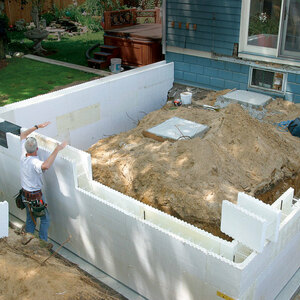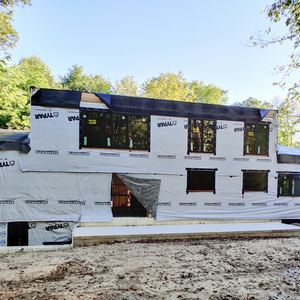
The spike in lumber prices during the pandemic got people like GBA reader srasic wondering whether houses built with insulating concrete forms (ICF) could be competitive in cost.
“Curious if people think this still holds true today or will in 2023,” he writes in this recent Q&A post. “I know lumber prices have gone down but they still seem to be a lot higher then pre-pandemic. When comparing I’m looking at ICF vs. a high-performance ZIP sheathing and exterior insulation.”
Although srasic acknowledges that no one can predict what will happen to lumber prices over the next year, he’s still curious about how much of a premium he might have to pay for ICF construction and whether the added cost is worth it.
That’s where we start this Q&A Spotlight.
ICF construction costs more
Jberks has poked into a similar question—how wood-frame construction compares with insulating composite concrete forms (ICCF), which are roughly the same in cost as ICFs.
“I’m not going to get into the merits and greenery of ICCF vs. ICF,” he writes. “I’ll let you guys on this post squabble about that. However, based on my curiosity, I took an hour of my time to do a very simple estimate to compare cost of a wood wall with exterior insulation vs. ICCF. ”
In his rough comparison, Jberks found that a 10-ft. by 10-ft. wood-framed wall section consisting of 2×6 studs, mineral wool batts, 3/4-in. sheathing, a liquid-applied water resistive barrier, and 1-1/2 in. of exterior mineral wool board (total assembly R-28) would cost $754 (Canadian). A 9-1/2-in.-thick wood-framed wall assembly (R-34) would push the cost to $890 due to the higher cost of the studs.
For an 8-in.-thick ICCF R-24 wall, the cost would be $1,020, including steel rebar…
Weekly Newsletter
Get building science and energy efficiency advice, plus special offers, in your inbox.

This article is only available to GBA Prime Members
Sign up for a free trial and get instant access to this article as well as GBA’s complete library of premium articles and construction details.
Start Free TrialAlready a member? Log in















19 Comments
I looked into this a while ago. At first glance, ICF construction seems to win the argument on durability but then the walls still need siding, just like a wood frame building. With a few engineering upgrades a fairly standard wood frame can withstand some extreme conditions and if it’s kept dry through proper envelope detailing and upkeep (required for any type of building), it can also last forever. And then there is the roof, one of the most vulnerable parts of any buildings and that can’t be built with ICF.
The one area I could see an advantage to ICF would be in case of flooding but flood prone areas are never a wise place to start building. And maybe termites in regions that are very exposed as long as bugs don’t start dwelling into the foam.
ICF foundations seem like a more sensible area of use, but (where available) I found insulated precast concrete like Superior Walls to be a better option. The thinner precast walls involve a fraction of the concrete, they are typically installed in a single day. reasonably waterproof and require no further finish.
I'm not disagreeing with you on your comparison of ICF vs wood, but I thought I'd point out for the sake of accuracy, you certainly can use ICFs for roof construction.
I wonder how ICF compares to its close cousins - poured concrete or CMU construction? Both of them have the advantage that you can situate the insulation where you want it, and depending on the aesthetic, don't necessarily need siding.
I'm a fan of CMU construction. It's schedule friendly, modular, readily available, easily repaired, and plenty stout enough to add a rain screen to without the need for fussy spacing / stud requirements. Rot poof, etc.
Kyle,
I've never used it above grade. That would the wall look like? Much like a basement one, with foam and a stud wall on the interior?
If I were building above grade with CMUs, I'd use this product: https://www.greenbuildingadvisor.com/article/maine-firm-develops-a-new-type-of-insulated-block. Its thermal performance is better than a typical, insulated 2x6 stud wall and the faces are milled so they are glued together, not mortared. And you can add more insulation if you want. There are some project examples here: https://www.comfortblock.com/gallery/.
48 lbs each, sheesh :).
Looks neat though, I must have missed them. That's a thick wall @ 16".
From looking at them, I can't help but feel a regular 6" or 8" cmu with all of the insulation stacked on the outside would perform better and be easier to install, and use less concrete.
Kyle, 48 lbs is less than a typical bag of mortar, and they are using reduced-GWP concrete. I agree that for best performance, continuous exterior insulation is the way to go, but if you watch the installation videos you'll see that these blocks go up very quickly. The wall thickness argument always amuses me--unless you have very tight building setbacks that limit how thick your walls are, who cares if they are 10" or 12" or 16"? Thicker walls often create a cozy feeling. I'm not saying this type of construction would be my first choice, but if you have ever mixed mortar or set concrete blocks, you might appreciate how easy these go together.
Mike,
Those are neat. I'm always a bit wary of niche European products though. I don't specify anything that isn't available in my local lumberyard, or one of a few local suppliers. That may mean using common but perhaps inferior materials, but it also means that any improvements in the efficiency of my building assemblies are easily replicated without disrupting either the way things are usually done by trades, or their regular supply lines.
It's really not all that different from a wood stud wall, with a few exceptions. just replace the studs / sheathing with CMU that's reinforced / grouted to the degree needed. It's def. more labor intense, but per square ft, the cost isn't all that unreasonable compared to a 'nice' zip/taped 2x6 wall.
A quick back of the envelope based on my local prices show that a 4x8 section of wall with is about 10-15% more expensive at the current prices, compared to a 2x6 wood framed wall. It was coming out ahead when lumber was crazy.
Malcolm (response to #10), they are European-inspired but made right here in Maine. I agree that when possible it's best to stick with what's available at the lumberyard, but somebody has to drive the industry forward and many lumberyards are woefully behind the times. For example, I've been using Zip sheathing (from a lumberyard) for 10+ years, and in some parts of the US it's still not available, or only by special order. Again, I'm not saying everyone should start using Comfortblock, I'm just suggesting that it's a better alternative to conventional CMU construction.
Mike,
Made in Maine. That's great!
We occupy differing ends of the spectrum in term of our practices - and I'm very grateful to people like you, Ben and others for driving building practice forward. My own approach is to offer small incremental improvements over what here in BC is an already a well functioning house if you follow good practices. Being in a temperate climate, with a code that intelligently addresses it, puts me in an enviable position.
@Michael Maines
Continuing here from the reply limit -
I've laid enough myself to know that the weight and productivity go hand in hand. It's not that 48 lb is a lot, it's a lot 150 times a day, every day.
Is there a discussion elsewhere between using ISPs vs Stick Frame construction?
Mick,
ISPs?
Mick, I'm guessing you mean SIPs--structural insulated panels? There have been many discussions on GBA about them over the years. Here's a recent one: https://www.greenbuildingadvisor.com/article/rotting-walls-in-a-sip-house.
Yes. SIPs. Sorry for my dyslexic typing.
Thanks for the link.
Mick916,
Ah - got it!
At any given time there is usually a discussion here about either spray foam remediation, or a SIPs failure. If everything is goes right they appear to work well, but my own feeling is that the regular and largely irremediable nature of their failures makes them uniquely risky things to include in a build.
I've seen a couple Youtube videos ("Up To Kode" is one of them) of ICF proponents touting the "thermal mass" of ICF. Not sure if it's overstated or simply untrue, but it doesn't make sense to me given that the insulation is equal on both sides of the concrete thermal mass.
Log in or become a member to post a comment.
Sign up Log in